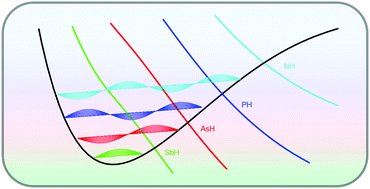A theoretical study on laser cooling feasibility of XH (X = As, Sb and Bi): effects of intersystem crossings and spin–orbit couplings†
Abstract
We investigate the low-lying electronic states and feasibility of direct laser cooling of AsH, SbH and BiH by means of the highly accurate ab initio and dynamical methods with the inclusion of the spin–orbit coupling effects. Twelve low-lying Ω states for each of them are computed using the internally contracted multireference configuration interaction method. Our computed spectroscopic constants are in excellent agreement with the available experimental data. The calculated spin–orbit matrix elements are large enough, and thus the intersystem crossings from the A3Π state and the transitions to the a1Δ2 state should be considered in laser cooling. We find that, from AsH to BiH, the location of the crossing point between the A3Π and 5Σ− states moves down towards the ground vibrational level of A3Π along with enhanced spin–orbit coupling effects, which increases the difficulty of laser cooling heavier hydrides. An empirical law of “crossing point shifting down” down a group in the periodic table is generalized, which may become a helpful caveat when cooling diatomic molecules containing heavier elements. By choosing specific spin–orbit states, we construct feasible laser cooling schemes for AsH and SbH based on the A3Π2 → X3Σ−1 transitions, which feature very large vibrational branching ratios R00 (AsH: 0.9662; SbH: 0.9248) and short radiative lifetimes (AsH: 914 ns; SbH: 883 ns). In particular, a constructed laser cooling scheme for AsH is able to scatter 1.24 × 104 photons, whereas that for SbH can scatter 8.60 × 103 photons, which are enough to cool AsH and SbH to the ultracold regime. The present work demonstrates the importance of intersystem crossings and spin–orbit couplings in molecular laser cooling.

- This article is part of the themed collections: Quantum computing and quantum information storage: Celebrating the 2022 Nobel Prize in Physics and Quantum Computing and Quantum Information Storage


 Please wait while we load your content...
Please wait while we load your content...